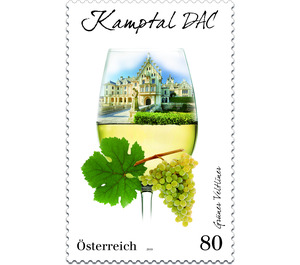Series: Austrian wine regions - Kamptal DAC - Austria / II. Republic of Austria 2019 - 80 Euro Cent
Theme: Cuisine & Groceries
| Country | Austria / II. Republic of Austria |
| Issue Date | 2019 |
| Face Value | 80.00 |
| Color | multi-colored |
| Printing Type | offset |
| Stamp Type | Commemorative |
| Item Type | Stamp |
| SID | 765466 |
| Dimensions | 32.00 x 51.00 |
| In 72 Wishlists | |
In the “Austrian wine regions” series, this time it is the idyllic Kamptal in the Lower Austrian Waldviertel region that is the focus. Kamptal DAC is a fresh, dry white wine with an unmistakeable flavour. Wine from the Kamptal The symbiosis of climatic influences and soil characteristics – the so-called “terroir”– determines the character and stylistic features of the wines. Typical features of the Kamptal’s climate are relatively hot days and cool nights in the summer and long, sunny autumn days. The soils are also very varied: depending on the precise composition and location, primeval rock, loess, loam soils, sandstone and gravel influence the various flavours of the wines. Only wines of the Grüner Veltliner and Riesling varieties are entitled to carry the designation “Kamptal DAC” (Districtus Austriae Controllatus), used to denote the wines typical for the region since 2008. Grüner Veltliner Kamptal DAC is a fruity, delicately spicy wine, whilst the Riesling has an aromatic, elegant and mineral flavour. A multi-level system distinguishes between Kamptal DAC with no more precise designation and those wines which also state the place of origin or the name of a vineyard, as well as the full-bodied reserve wines. Some of the best-known vineyards in the Kamptal are the Heiligenstein, the Wechselberg or the Käferberg. The landscape: The Kamptal wine region is the second largest wine growing region in Lower Austria after the Weinviertel. It derives its name from the river Kamp, which flows into the Danube east of Krems. Around 3,900 hectares of vineyards are currently being cultivated in the Kamptal, in some cases in steep terraces. A particular regional attraction is the Loisium in Langenlois, which impresses with its wine experience exhibition and with its architectural extravagance. Aside from wine, the area around the Kamp is also home to popular destinations for day trips, such as the Ottenstein reservoir and Ottenstein Castle, the Renaissance Rosenburg Castle or the romantic Grafenegg Castle with its famous culture summer, which also features on the special stamp. The nostalgic Kamptal Railway invites you to explore the surroundings by train, and many hiking trails, including those in the Kamptal-Schönberg nature park, lead visitors through the impressive fluvial landscape and the forested slopes of the Manhartsberg.


